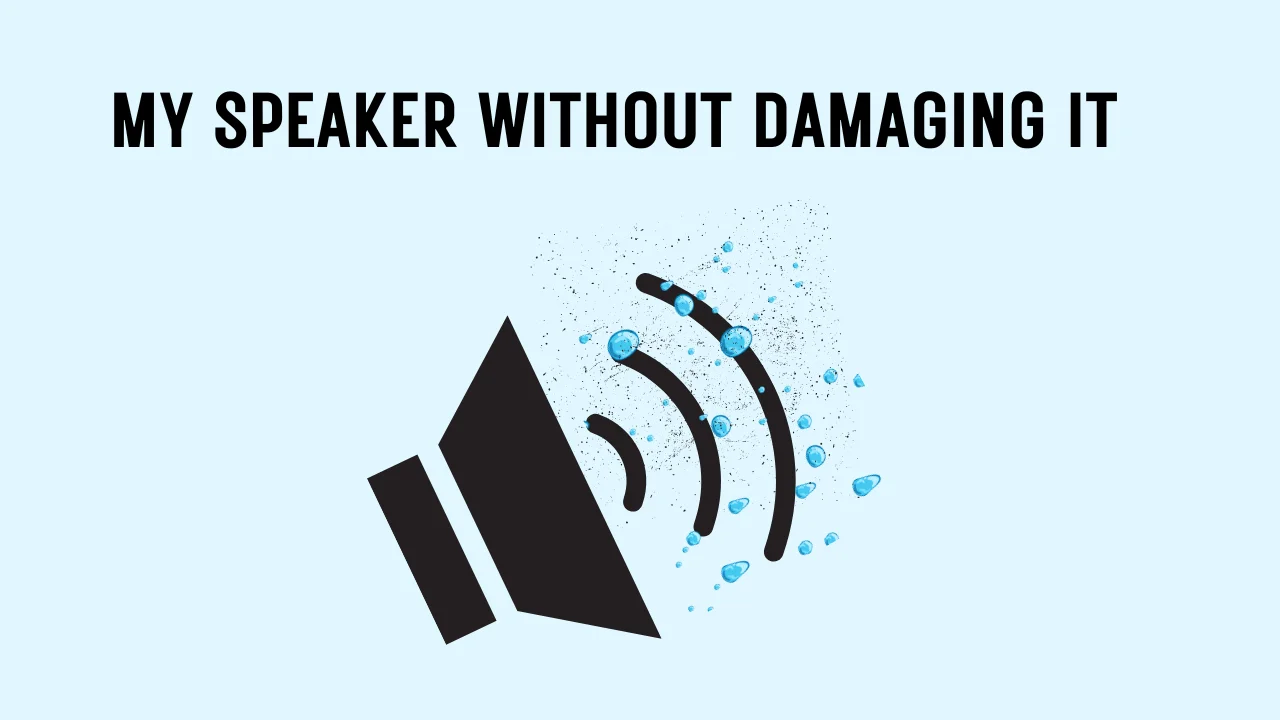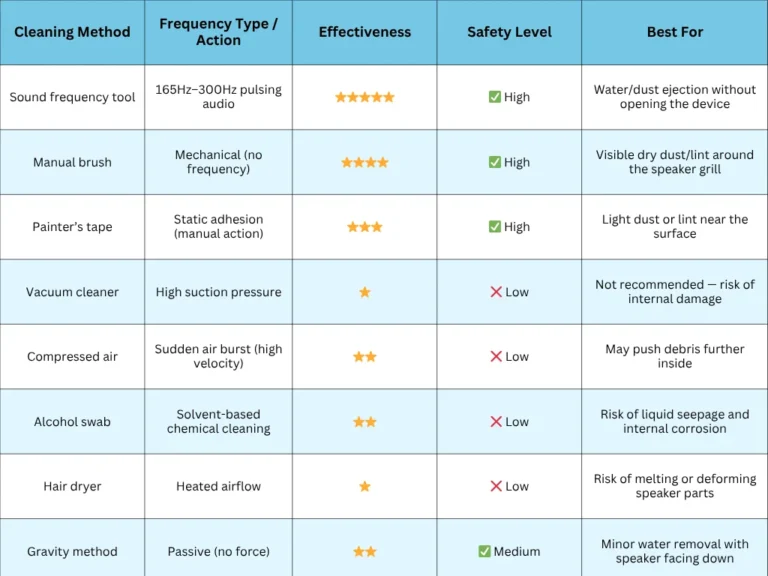How to Clean My Speaker Without Damaging It: Simple Fixes That Actually Work

Have you ever heard your phone’s speaker sound muffled or dull while listening to music or making a call? This is a very common problem that typically indicates the presence of moisture, lint or dust accumulation. Over time, a lot of microscopic particles infiltrate the speaker grill and obstruct clear sound transmission. Ignoring this could even harm the speaker’s long-term functionality.
Fortunately, there are easy and safe ways to deal with this at home. You don’t need dangerous hacks or sharp tools. All you need is the correct approach and a little patience. We’ll demonstrate how to clean my speaker guide here, using methods that are safe for your phone and truly effective. Let’s get started.
Why Your Speaker Sounds Muffled or Quiet
Even if your phone appears to be in good condition, sound problems can appear. You might notice that the music sounds dreary, your calls are unclear, or the volume is lower than it used to be. These are not sporadic problems; rather, they are typically brought on by every day, commonplace causes. To fix the issue safely, the first step is to identify its source.
Dust and Pocket Lint
Small fibers from your pocket or bag may not seem like much, but they quickly accumulate. Debris builds up in the speaker grill each time you slide your phone into your jeans or place it on a dusty table. Initially appearing innocuous, this accumulation eventually gets dense enough to obstruct sound waves.
The speaker problems are directly correlated with the amount of dust and lint. Sounds are muffled more when there is more lint and dust present. This is among the most prevalent problems. Fortunately, though, it is also among the simplest to repair with consistent attention.
Moisture from Bathrooms, Kitchens or Weather
Phones are everywhere, even in places they shouldn’t be. Your phone is exposed to moisture and humidity when you answer a call while cooking, taking a shower, or going outside in the rain. It is possible for even a slight mist to enter the speaker mesh.
Temporary distortion, decreased volume, or even crackling sounds may result from the moisture. Moisture can cause internal connections to break or metal components to corrode if they are left inside the speaker chamber.
Clogged Speaker Mesh
The speaker mesh serves as a net of protection. It may also work against you. Although it traps dirt and dead skin cells, it is made to keep larger particles out of the speaker. Over the course of weeks or months, the mesh becomes packed with dirt.
At this point, the speaker finds it difficult to effectively emit sound waves. Particularly during calls or voice messages, you might hear a drop in bass, hazy vocals, or uneven audio.
Accidental Pressures or Drops
Internal speaker components can be harmed by dropping your phone, sitting on it or inadvertently applying too much pressure close to the speaker. Internally, the speaker may become misaligned or blocked.
Until the audio begins to sound tinny or distant, you might not even notice it at first. Additionally, the speaker’s casing may move slightly to trap dust or constrict airflow, which would lessen the clarity of the sound.
Is It Safe to Clean Your Phone Speaker at Home?
Yes, cleaning your speaker at home is safe. Only if you do it correctly will it occur. Many people attempt do-it-yourself methods they find online, but not all of them are safe for your device. Some may even exacerbate the issue. Understanding which approaches to avoid is as crucial as understanding which ones are effective.
Let’s review some popular practices and the reasons they pose a risk:
Using Sharp Objects to Poke the Speaker
We all know it’s tempting to grab a needle or pin and dig into the speaker holes. It happens especially when dust is visible. But this is one of the quickest ways to cause damage. Internal components are fragile. The mesh or loosen parts inside can be broken even by a slight poke.
Blowing Air with Your Mouth
Blowing might seem harmless on outside, but your breath carries moisture. You might be adding humidity not removing it, when you blow into the speaker grill. That moisture can sneak in and lead to crackly or distorted sound later on.
Trying Vacuum Cleaners or Compressed Air
While it may seem logical, using vacuums or canned air often applies too much pressure. Instead of pulling debris out, these tools can push it deeper inside. In worst cases, strong suction can also damage speaker seals.
Using Alcohol or Liquid Cleaners
Rubbing alcohol and cleaning sprays are meant for screens, not speakers. Liquids can seep into small openings and corrode internal parts. Even if the phone still works after, sound quality might take a permanent hit.
Overheating with Hair Dryers
Some people try using a blow dryer to “dry out” water trapped in the speaker. But most dryers blow hot air that can melt or warp plastic components. Plus, heat won’t fix dirt buildup — it just adds more risk.
Best Safe Methods to Clean Speaker at Home
It’s natural to want a quick fix, when your phone’s sound is weak or muffled. The good news is you don’t need tools or special skills to clean it safely. There are a few effective techniques that work well without damaging your device.
Let’s go over the safest methods that users rely on:
Use a Soft-Bristled Brush
A dry and clean makeup brush or a soft toothbrush works great for removing surface dust. Gently brushing the speaker grill in circular motions can help lift out lint and grime without applying pressure or poking inside.
Try Sound Frequency Cleaning Tools
Some tools — like the Fix My Speakers— use sound vibrations to eject dust and water from the speaker grill. These tools play specially tuned audio pulses that shake out dirt. They’re non-invasive, touch-free and surprisingly effective.
Use a Small Piece of Painter’s Tape
Try to wrap a bit of painter’s tape (sticky side out) around your fingertip and lightly press it over the speaker. The adhesive lifts out surface particles without leaving residue or pulling at internal parts. Avoid duct tape or stronger adhesives as they can cause damage.
Let Gravity Do the Work
If you suspect water is inside the speaker, place the phone upright with the speaker facing down. Let it sit for 30–60 minutes. Gravity often helps moisture drain out naturally. If you combine this with a gentle vibration sound, you will get better results.
Dry It in Front of a Fan (Not Heat)
A room-temperature fan placed a few inches from your phone can help evaporate any trapped moisture safely. Never use hot air or heating elements. Even slightly warm air is enough when paired with time and airflow.
Related Guides You Might Find Useful:
- How to Eject Water from iPhone Speaker
Step-by-step method to remove moisture safely using sound waves—perfect next-step if your speaker is water-affected. - Water Eject Sound for AirPods
Want a similar quick method for your AirPods? This guide uses special sound frequencies to help eject water without damage. - Why Speaker Is Not Working Properly?
Discover common causes behind distorted or non-functioning speakers and easy fixes to get things back to clarity. - Fixes for Your Laptop’s Muffled Audio
Noticed muffled sound on your laptop too? This guide walks you through cleaning tips and troubleshooting advice for clearer audio.
How Often Should You Clean Your Phone Speaker?
Even if your phone sounds fine now, dirt and moisture build up slowly over time. By regular maintenance, you can prevent sound issues before they start. You don’t need to clean your speaker daily, but setting a simple routine can make a big difference.
Here’s a practical guide on when and how often to check and clean it:
Every 1–2 Weeks: Quick Visual Check
Take a moment to inspect the speaker grill. If you see lint, dust or smudges, it might be time for a gentle cleaning with a soft brush or tape.
After Exposure to Moisture
Accidentally took a call in the rain or near the sink? Even small amounts of water can settle in the speaker. After any exposure, use a fan or play audio frequencies right away to prevent internal moisture buildup.
Monthly: Full Cleaning Routine
Once a month, do a more detailed cleaning. Use a brush, then play a cleaning sound if needed. This keeps performance at its best and avoids long-term blockage.
If You Notice Muffled Sound or Low Volume
Any time your audio sounds “off,” it’s your cue to act. Don’t wait for it to fix itself. Take a few minutes to clean and see if it improves — it usually does.
Comparison of Speaker Cleaning Methods

Conclusion
Most people don’t realize how simple it is to maintain the speaker on your phone. With the correct techniques and a little caution, you can prevent major sound problems. Risky do-it-yourself techniques that could do more harm than good must be avoided. Repair is never as good as prevention and routine cleaning.
The answer to the question, “How can I clean my speaker safely?” is straightforward: employ tried-and-true methods. Modern solutions, such as non-invasive cleaning options and audio-based tools, make the task simple. To preserve speaker clarity, always opt for safe, tried-and-true methods. This keeps your device loud, clear, and long-lasting.
FAQs
Can speaker mesh block sound output?
Yes, dirt or moisture trapped in the mesh can muffle or distort sound. It acts like a barrier, reducing speaker clarity and volume.
What kind of sound waves remove debris from speakers?
Low-frequency pulses between 100Hz and 500Hz are most effective. These vibrations help dislodge water and dust without damaging components.
Will cleaning the speaker improve phone performance?
It won’t affect speed or battery, but it can restore clear sound output. That’s important for calls, videos, and alerts.
Is using alcohol safe for cleaning phone speakers?
No, liquids like alcohol can seep inside and damage internal circuits. Stick to dry or sound-based cleaning methods.
